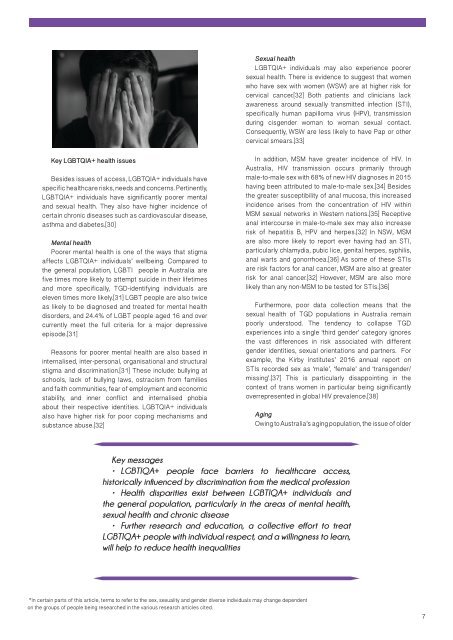Vector Volume 11 Issue 2 - 2017
Create successful ePaper yourself
Turn your PDF publications into a flip-book with our unique Google optimized e-Paper software.
Sexual health<br />
LGBTQIA+ individuals may also experience poorer<br />
sexual health. There is evidence to suggest that women<br />
who have sex with women (WSW) are at higher risk for<br />
cervical cancer.[32] Both patients and clinicians lack<br />
awareness around sexually transmitted infection (STI),<br />
specifically human papilloma virus (HPV), transmission<br />
during cisgender woman to woman sexual contact.<br />
Consequently, WSW are less likely to have Pap or other<br />
cervical smears.[33]<br />
Key LGBTQIA+ health issues<br />
Besides issues of access, LGBTQIA+ individuals have<br />
specific healthcare risks, needs and concerns. Pertinently,<br />
LGBTQIA+ individuals have significantly poorer mental<br />
and sexual health. They also have higher incidence of<br />
certain chronic diseases such as cardiovascular disease,<br />
asthma and diabetes.[30]<br />
Mental health<br />
Poorer mental health is one of the ways that stigma<br />
affects LGBTQIA+ individuals’ wellbeing. Compared to<br />
the general population, LGBTI people in Australia are<br />
five times more likely to attempt suicide in their lifetimes<br />
and more specifically, TGD-identifying individuals are<br />
eleven times more likely.[31] LGBT people are also twice<br />
as likely to be diagnosed and treated for mental health<br />
disorders, and 24.4% of LGBT people aged 16 and over<br />
currently meet the full criteria for a major depressive<br />
episode.[31]<br />
Reasons for poorer mental health are also based in<br />
internalised, inter-personal, organisational and structural<br />
stigma and discrimination.[31] These include: bullying at<br />
schools, lack of bullying laws, ostracism from families<br />
and faith communities, fear of employment and economic<br />
stability, and inner conflict and internalised phobia<br />
about their respective identities. LGBTQIA+ individuals<br />
also have higher risk for poor coping mechanisms and<br />
substance abuse.[32]<br />
In addition, MSM have greater incidence of HIV. In<br />
Australia, HIV transmission occurs primarily through<br />
male-to-male sex with 68% of new HIV diagnoses in 2015<br />
having been attributed to male-to-male sex.[34] Besides<br />
the greater susceptibility of anal mucosa, this increased<br />
incidence arises from the concentration of HIV within<br />
MSM sexual networks in Western nations.[35] Receptive<br />
anal intercourse in male-to-male sex may also increase<br />
risk of hepatitis B, HPV and herpes.[32] In NSW, MSM<br />
are also more likely to report ever having had an STI,<br />
particularly chlamydia, pubic lice, genital herpes, syphilis,<br />
anal warts and gonorrhoea.[36] As some of these STIs<br />
are risk factors for anal cancer, MSM are also at greater<br />
risk for anal cancer.[32] However, MSM are also more<br />
likely than any non-MSM to be tested for STIs.[36]<br />
Furthermore, poor data collection means that the<br />
sexual health of TGD populations in Australia remain<br />
poorly understood. The tendency to collapse TGD<br />
experiences into a single ‘third gender’ category ignores<br />
the vast differences in risk associated with different<br />
gender identities, sexual orientations and partners. For<br />
example, the Kirby Institutes’ 2016 annual report on<br />
STIs recorded sex as ‘male’, ‘female’ and ‘transgender/<br />
missing’.[37] This is particularly disappointing in the<br />
context of trans women in particular being significantly<br />
overrepresented in global HIV prevalence.[38]<br />
Aging<br />
Owing to Australia’s aging population, the issue of older<br />
Key messages<br />
• LGBTIQA+ people face barriers to healthcare access,<br />
historically influenced by discrimination from the medical profession<br />
• Health disparities exist between LGBTIQA+ individuals and<br />
the general population, particularly in the areas of mental health,<br />
sexual health and chronic disease<br />
• Further research and education, a collective effort to treat<br />
LGBTIQA+ people with individual respect, and a willingness to learn,<br />
will help to reduce health inequalities<br />
*In certain parts of this article, terms to refer to the sex, sexuality and gender diverse individuals may change dependent<br />
on the groups of people being researched in the various research articles cited.<br />
7

















